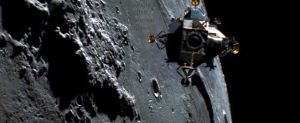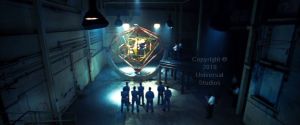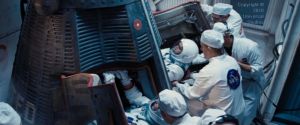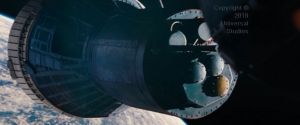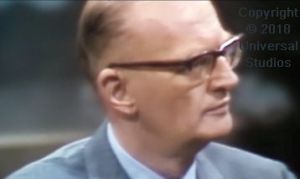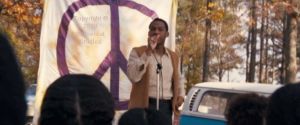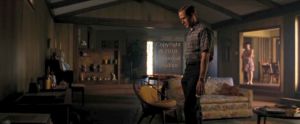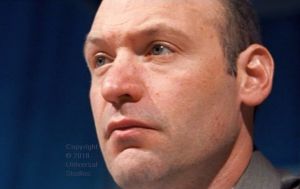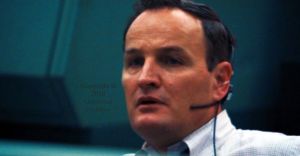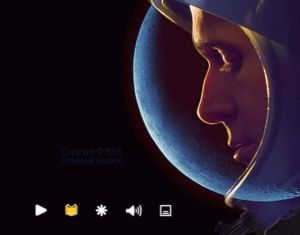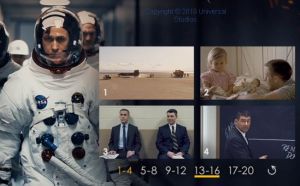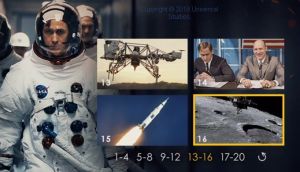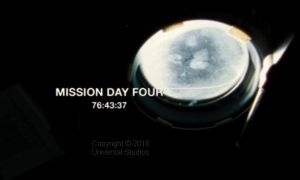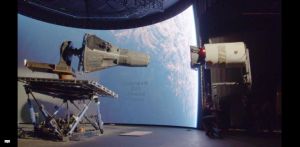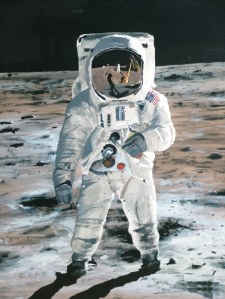Home (contents) → Movie reviews and overviews → T minus 15 seconds, guidance is internal
T minus 15 seconds, guidance is internal
First Man, Universal Pictures, 2018, reviewed by Everard Cunion in May 2019
I’m not the man they think I am at home
— From the lyrics of Rocket Man by Elton John and Bernie Taupin, 1972
I regard myself as fairly knowledgeable about flight in general, including space flight, but this film shows, early on, an upsetting episode in the life of Neil Armstrong, commander of the first manned moon landing mission, of which I was previously unaware. (If you are easily upset to a large extent, you might want to give this film a miss.) It cast a long shadow that affected Armstrong throughout the rest of his life, at least according to this movie. As he says in the film (in which he is played by Canadian actor Ryan Gosling) when asked about it during his selection interview for the Gemini (two-man spacecraft) program, “I think it would be unreasonable to assume that it wouldn’t have some effect.”
Armstrong’s two sons were consulted during the making of the film, so it seems to me likely to be close to the truth, although perhaps it includes some exaggeration in places for dramatic effect. Armstrong was a private individual and it seems likely to me that this film reveals his character in hitherto unparalleled definition.
The opening scenes depict Armstrong flying the X-15 rocket-powered airplane to the edge of space. The film makers used a combination of modern special effects and the results seem to me most realistic, although my qualifications for that judgement are constrained by my flying experience being limited to the relatively low-speed realm of hang gliding.
The vibration, clanking, and creaking—which I have not come across in other space films, at least not to this extent—accords with what I have read about these experimental flying machines and the early spacecraft. Yet the lunar module is portrayed as less noisy than it actually was…
“The skin of the LM was so thin,” says Apollo 10 commander Tom Stafford, “and the thrusters were right there in front of you. If you want to simulate flying a lunar module, take a washtub, put it over your head, and have a kid bang on it with a hammer.”
— from We Called it ‘The Bug’ by D.C. Agle in Air & Space, August/September 2001
The film uses a technique of cutting often between work (lectures and training at NASA, then actual space missions) and home, where Armstrong’s wife and children interact with each other and with neighbouring families. If that were done too often, it would be distracting. It seems to me about right.
The NASA multi-axis trainer facility was used for providing experience in so-called ‘roll-yaw coupling’ of the type encountered by test pilots of the early supersonic aircraft that were longer than they were wide.
One of my pet hates in movies is obtrusive and inappropriate backing music that sounds as if it was created solely to keep musicians in work. Fortunately, the backing music here is subtle, yet it avoids being tuneless muzak, and it seems to me to enhance the effect of the visuals. More than that, the music accompanying the final approach and landing of the lunar module (The Landing by Justin Hurwitz) is certain to become a mainstay of full orchestra renditions of film backing music.
Discussing plans for the first EVA (‘space walk’) astronaut Ed White says, “…the walking’s the easy part. It’s getting back inside that’s tough.” Whether anyone really considered that ahead of time, I do not know, but cosmonaut Alexei Leonov, the first person ever to climb out of a spacecraft in space, had to partially deflate his space suit to get back inside!
Here, astronauts and their wives watch Alexie Leonov’s ‘space walk’ on television. Ed White (played by Jason Clarke)–the first American to ‘walk in space’–is standing at right and Armstrong (Ryan Gosling) is at the back.
The external view of the crew boarding Gemini 8 is followed immediately by a point-of-view sequence as Armstrong squeezes into his ejection seat. (Unlike the earlier Mercury and later Apollo spacecraft, the Geminis were not equipped with escape towers.)
Scott and Armstrong docked their Gemini with the unmanned Agena without difficulty. Then a malfunction nearly cost them their lives, being averted only by the astronauts’ ‘right stuff’: Their ability to comprehend three-dimensional rotation and counter it while under great physical strain caused by rotational acceleration. If they had not brought the spacecraft under control quickly, it would have broken apart. That life-or-death struggle in space is portrayed most realistically in this film, it seems to me.

“But you’re a bunch of boys making models out of balsa wood! You don’t have anything under control!”
When her loudspeaker connection to the radio dialog between Gemini 8 and Mission Control is turned off, Janet Armstrong, played by English actress Claire Foy, lets rip. She is portrayed as a tower of strength on the proverbial ‘home front.’
According to the Wiki, the real Janet Armstrong died a few months before the film was released.
“Neil looked up and I said, ‘I just heard the funniest story!’ He said, ‘What?’ I said, ‘I heard that you bailed out of the LLTV an hour ago.’ He thought a second and said, ‘Yeah, I did.’ I said, ‘What happened?’ He said, ‘I lost control and had to bail out of the darn thing.’
— Apollo 12 lunar module pilot Al Bean quoted in First Man, The Life of Neil A. Armstrong by James R. Hansen, 2005
Armstrong’s ejection from the out-of-control LLTV (derived from the earlier LLRV) which the astronauts used to train for the lunar landing, was another point in Armstrong’s flight test career where he demonstrated his ‘right stuff’; attempting to regain control and save the craft from destruction, ejecting only at the last second. The film makers went to a lot of trouble over it and I feel that the result effectively imparts the required emergency feel of a flight test gone wrong.
The film includes snippets from television of the time including opinions by Kurt Vonnegut and even a brief glimpse (un-accredited) of Arthur C. Clarke, who wrote 2001 a Space Odyssey with Stanley Kubrick.
In the following, don’t confuse Nell with Neil…
A rat done bit my sister Nell, with Whitey on the moon.
Her face and arms begin to swell, and Whitey’s on the moon.
I can’t pay no doctor bills, but Whitey’s on the moon.
Ten years from now I’ll be payin’ still, while Whitey’s on the moon.
— Gil Scott-Heron, the ‘godfather of rap’, played in the film by soul singer Leon Bridges
Scenes such as this in the spacious Armstrong house (after they moved from the cabin in Juniper Hills) where Neil and Janet watch a television report of Apollo 10, help tell the story while being also visually interesting. (Apollo 10 went to the moon with a complete rig, but it did not land. It was too heavy to get back up if it did.)
“Their working relationship, as I saw it, was always extremely polite and, from Neil to Buzz, in no way critical. What Neil actually thought about Buzz, God only knows.”
— Apollo 11 command module pilot Mike Collins quoted in First Man, The Life of Neil A. Armstrong by James R. Hansen, 2005
Corey Stoll comes across almost as over-the-top as the real Buzz Aldrin.
Paul Calle, played by his son Chris, is depicted at work in the movie. I cannot help thinking that Calle was the inspiration behind the people sketcher in the 1975 Stepford Wives movie, in which the engineers of the American space program turn their talents to creating artificial people. See my review.
The three actors who collectively play the crew of Apollo 11 look different enough so that you know who you are seeing. That is an improvement on the reality, at least with the low-resolution imagery of the time, where they looked so similar you normally had no idea who you were looking at.
Actual film from the NASA archive is used, its restoration funded by this movie project.
Ed White, the first American to ‘space walk’, is a played most impressively by Jason Clarke, who comes across as a larger-than-life character. His fate underscores the point of this film, which is to show the general danger and difficulty inherent in experimental flight, including space flight, and to illustrate particularly how Neil Armstrong was affected by the inevitable tragedies encountered when participating in such projects.
This still image from film shot at the time illustrates the gargantuan size of the Saturn V/Apollo moon rocket. The tiny white cone at upper right, beneath the long thin probe (the escape tower) is the roomy three-man command module. (You might make out its cone of cavitation condensation, much smaller than that which envelops the middle of the rocket.) The silver cylinder (the service module) connecting the command module to the tapered white stage (containing the lunar lander) was full of equipment and machinery and was accessible only from outside.
At first I assumed that the zero-G sequences inside the command and lunar modules were created by filming inside the body of a ‘vomit comet’; a converted cargo airplane flying a parabolic arc, providing a minute or so of weightlessness. (That was how it was done in the 1995 movie Apollo 13. How the zero-G air lock scene in the 1968 film 2001 a Space Odyssey was achieved—before there was a vomit comet and before digital effects—is a remarkable story. I placed a link to an explanation farther down.) However, in First Man, they used trickery that included suspending objects on fine wires on which they could spin and appear to be floating in zero G. According to the optional voice-over by three of the people who made the film, that technique was augmented by tilting the set to disorient the viewer. The camera follows one of the astronauts as he floats from the command module through the tunnel to the lunar module and it swings around to his upside-down comrade, who closes the connecting hatch. (Is the floating astronaut a stunt man suspended by wires and hauled upwards by an electric winch?) That scene is similar to the equivalent in Apollo 13 (1995) but, astonishingly, it is even more real looking in First Man.
The dialog between the space crewmen and Mission Control has the several second delay between message and reply—caused by the distance between the moon and the earth—edited out. Similarly, the frantic looking up of the navigation computer program documentation at Mission Control when the 1202 alarm sounds is compressed.
Shortcut to the landing sequence
If you see nothing else of this movie, I recommend at least watching it from chapter 16, which covers the moon landing. It is then 10 minutes to touch-down on the surface of the moon. Twenty-four minutes to the end of the film (excluding the end titles). I based the following instructions on the 2018 Universal Pictures DVD.
That section includes the most amazing zero-G effects I have seen. The backing music The Landing by Justin Horwitz starts at the moment when the command and lunar modules separate. Aldrin reads out height, rate of descent, ground speed, and fuel state while Armstrong flies the craft manually. (There was no head-up display available at the time.)
I start at chapter 15 on my daily viewing, to see the entire Apollo 11 mission. The overused word awesome is inadequate.
Criticisms and observations
The film is all about Neil Armstrong, which is fair enough. I am not sure this is really a criticism, but I feel it worth pointing out that, when the Eagle touched down on the moon, Neil Armstrong and Buzz Aldrin touched down together. One might judge who was ‘first’ in terms of physical contact with the material of the moon itself. I assume that would be whichever of them was first to remove their helmet when back inside the lunar module after venturing outside. (I read that moon dust smells like gunpowder.) Which of them that was, I do not know. Does it matter? Anyway, I guess One of the First Two Men would not be a catchy film title.
The opening sequence, depicting an X-15 flight test, has some strange sound effects that resemble a propeller airplane and it is not clear that it starts with the rocket plane still attached under the wing of a B-52. Having said that, the film makers know their stuff and the alert person, which clearly I am not, might on his or her 100th viewing, notice that, when Armstrong looks to the left (at one minute and six seconds from the start on the 2018 DVD) he sees the nose of the B-52 ‘mother ship.’ (I then noticed that, seeing Armstrong in profile and, therefore, looking out sideways, we see the aluminium side of the B-52.)
If there were any clouds at that altitude, they would not be that kind of clouds.
The initial scene with Armstrong’s young daughter makes the basic mistake of unnecessary repetition, but thereafter the film picks up to the right pace, in my estimation. I feel that the early ‘family life’ scenes were overdone though.
I find many ‘people oriented’ scenes too close-cropped (zoomed in) for comfort. It imparts the feel of a film made for the small screen. Fortunately, many scenes, including those on the moon (filmed in some kind of gravel pit, apparently) are truly scenic.
This is not a criticism either, although I initially considered it one. (I have retained this paragraph because I believe it to be interesting.) In orbit around the moon in the lunar module, Ryan Gosling steps back and forth to change view from his main triangular window to looking out of one of the overhead windows. At that point in reality the astronauts were in zero-G, so it seemed to me that there could be no stepping of any kind. However, they were restrained from floating around the cabin by elastic chords fastened to the floor at one end and hooked onto the sides of their space suits at waist level at the other, so such movement was possible. In any case, when they use the engine to drop down to the surface, some virtual body weight returns, firstly from the acceleration imparted by the rocket engine, and then (after touch-down) from the moon’s own gravity.
In the movie, Buzz Aldrin announces the illumination of the contact light (on the instrument panel) after the lunar module lands. In reality, the light comes on when a surface sensing probe touches the surface. (Three of the four landing legs had such probes hanging down underneath.) The real Buzz Aldrin announced it as soon as the light came on so Armstrong knew to shut down the engine — and the spacecraft would drop the last few feet to land on the moon. However, Armstrong was concentrating on avoiding obstacles all the way to the surface and he ignored Aldrin’s call. (I have placed a link farther down to a recording of the actual landing.) As a result, the Eagle’s touch-down was the softest of all the moon landing Apollos.
“I called ‘Contact!’ Dave hit the button to shut off the engine and we hit hard. It was the hardest landing I have ever been in. Everything rocked around and I thought the gear was going to fall off.”
— Apollo 15 lunar module pilot Jim Irwin in To Rule the Night, 1973
Chief of the astronaut office Deke Slayton, played by Kyle Chandler, does not seem much like the Deke Slayton described by Tom Wolfe…
There always seemed to be a couple of good buddies from Valdosta or Oilville or some place sitting around saying:
“I tol’im iffie tried to fuck me over, I was gonna kick’is fuckin’ ass, iddnat right?”
“Fuckin’ A.”
“Soey kep’on fuckin’ me over and I kicked ‘is fuckin’ ass in fo’im, iddnat right?”
“Fuckin’ A.”
“An’ so now they tellin’ me they gon’ th’ow my fuckin’ ass inna fuckin’ stoc-kade! You know what? They some kinda fuckin’ me over!”
“Fuckin’ A well tol’, Bubba.”
Now that Deke was all of a sudden a celebrity, there were people who knew him who cringed every time he got near a microphone.
— Tom Wolfe, The Right Stuff, 1979
Not a criticism — because it is certainly deliberate — but the poor condition of the command module windows that made viewing the moon through them so difficult was the experience of the Apollo 8 crew. (They orbited the moon in December 1968, but without a lunar module.) According to Andrew Chaikin in his ground-breaking book A Man on the Moon, the Voyages of the Apollo Astronauts, the problem partly resulted from a sealing compound that decomposed in the vacuum of space. Including that problem for dramatic effect in this film, I feel, enhances its value as a representation of the whole adventure.
One fault that the DVD has in common with many films on DVD–so this is not a criticism of the film itself–is the poor usability of the menu system, the main page of which contains buttons represented by largely meaningless graphic icons with no accompanying text. (Not even hover text.) So you just have to guess what they do or click each one to find out.
Assessment
The selection of Ryan Gosling to act the part of the sometimes touchy (but definitely not touchy-feely) Armstrong, a thinking man, navy fighter pilot, test pilot, glider pilot, and engineer, seems to me a touch of genius. Gosling seems highly attuned to human difficulties and sometimes contrary behaviours exhibited by those whose social skills are different from the norm. Just like Lars Lindstrom, the character he played 11 years before First Man, his portrayal of Neil Armstrong clearly shows that, at times, Armstrong struggled with personal interaction.
If he had been a young boy selling subscriptions at the door, one grandmother might have warned her granddaughter never to let him in the house; another would have commented, “That boy will go very far.”
— Norman Mailer describing Armstrong in A Fire on the Moon, 1970
Armstrong is popularly misunderstood. Possibly because of celebrity culture, the media relate the extraordinary achievement of landing on the moon with a Superman figure, who they imagine to be Neil Armstrong. While Armstrong was immensely qualified to be that ‘first man’, it was only the accident of crew selection in the progression of the manned Apollo space flights that placed Armstrong in that position. As he pointed out more than once, several crews were ready and capable of making that first landing. In telling Armstrong’s story in a new and emotive way, this movie helps set the record straight, in my opinion.
Journalist Norman Mailer, whose input features in the book by James Hansen on which the movie is based, brought to the attention of the world Armstrong’s character: The daring test pilot who was uncomfortable with describing or displaying emotion.
Like Mailer, we were to be the author of our own Moon landing.
— From First Man, The Life of Neil A. Armstrong by James R. Hansen, 2005
If the late Neil Armstrong is somehow able to watch this film, I am certain he will be amazed, shocked, and pleased at this necessarily compressed portrayal of his life.
The combination of special effects and real (restored) imagery from the time raises First Man to the top of the stack of space movies, those I have seen anyway.
Extras
The DVD includes several short documentaries about the making of the movie. They include 70mm film stored away for years in the NASA archive. Its restoration was funded by the makers of this movie.
One documentary shows, side by side, the movie’s version of Armstrong’s view of the last seconds to touch-down on the surface of the moon and the actual film on which it is based. Similarly with film of Armstrong descending and ascending the step-ladder (attached to one of the landing legs) to and from the lunar surface.
Here, the rear half of an X-15 made for the movie is set up on the simulator motion base. They also used a front half including the cockpit.
Personal notes
At the age of seven I was great at drawing space ships. My old dad said to my mum, “He’ll be the first man on the moon!” At 13 years old when Armstrong and Aldrin landed on the moon, I was just a spectator watching the barely comprehensible indistinct grey moving images on our small black-and-white television. Those images, incidentally, appear briefly in the film because that is also how the folks at Mission Control saw Armstrong’s ‘one small step.’
While the actors speak the astronauts’ lines, the voice of Mission Control during the landing is the real recording of astronaut Charles Duke. I recall his unmistakable voice from when he came to Bournemouth in 1985 to show the movies he took on the moon as lunar module pilot of Apollo 16.
This is not the first time Ryan Gosling has played a Rogallo test pilot. In Lars and the Real Girl, 2007, he played an exaggerated version of me, although there was no hang gliding in that movie either.
Arthur C. Clarke was missing from the cast list of First Man in Internet Movie Database (IMDB) so I sent in an update to add him, which was acted on the next day. He is in the section headed Rest of cast listed alphabetically. And, being a database, First Man has been added automatically to his filmography (under Archive footage).
Lastly, my thanks to Emily of North Carolina, who keeps up with modern things, and who alerted me to the existence of this fine movie.
Related
A ridge too far—my review of The Bridges at Toko Ri, 1954, a fictionalised account of US Navy F-9F Panthers in the war in Korea. Neil Armstrong was one of those pilots.
Fly Navy in My flying late 1970s and early 1980s: The British navy had a contraption similar to the NASA multi-axis trainer (pictured farther up) at their school of aviation medicine when I attended a hang gliding disorientation and decompression course there in 1982.
Lars and the real Everard–my review of the Canadian movie Lars and the Real Girl, 2007, also starring Ryan Gosling
Neil, containing some brief comments on two or three important scenes. They potentially constitute a plot spoiler, so I put them on a separate page.
Rocket science–my Glencoe Models 1/76th scale Vanguard unmanned research rocket, launched 10 years before Apollo 11
Round-Britain powerboat race 1969 — July 1969, same as the first moon landing
Saving Major Tom–my review of the 1967 James Bond film You Only Live Twice, which includes some real rocket launches as well as space special effects
Smilin’ Al, of the Cape—my review of Light This Candle, The Life and Times of Alan Shepard, America’s First Spaceman, by Neal Thompson, 2004
Space suits and frocks on the box—my review of The Right Stuff, 1983
External links
Apollo 11 landing from PDI to Touchdown video of the real landing from the NASA audio and video archive, on YouTube, starting 13 minutes and 45 seconds in
Armstrong’s Close Call, Neil Armstrong ejects from the lunar landing research vehicle in May 1968. Air & Space magazine. (1:32)
CM swing arm disconnect in Apollo 11 Pre-Launch Activities And Launch (1969) starting at 39 minutes and 10 seconds in — to compare with the movie
Crew walk out to the transfer van in Apollo 11 Pre-Launch Activities And Launch (1969) starting at 7 minutes and 37 seconds in — to compare with the movie, for which they used the same van — preserved by NASA
Early powered ultralights in Hang Gliding History, which includes a photo of the structure in which they assembled the Saturn V moon rocket, taken by Roly the sailmaker aboard a powered ultralight 30 years after Apollo 11
Enchanted Rendezvous, John C. Houbolt and the Genesis of the Lunar-Orbit Rendezvous Concept by First Man author James R. Hansen, December 1995 (Acrobat PDF document about rendezvous and docking in space). It includes a photo containing Verner Von Braun, Robert Gilruth, George Mueller, and rocket engineer Dr. Kurt Debus, the latter played by James R. Hansen in the movie.
FIRST MAN | Justin Hurwitz Featurette video on YouTube
Inside The Cockpit, Apollo Command Module 360 degree view on Air & Space
Joe Engle explains the problem of adverse yaw and why the X-15 had a large blocky tail: Joe Engle Oral History SDASM (San Diego Air & Space Museum) on YouTube starting at 40 minutes 13 seconds. He then describes briefly Armstrong’s trouble when he climbed after re-entry and only just made it back to base. Engle was a consultant during the making of First Man.
Keir Dullea on faking zero gravity in 2001: A Space Odyssey | Clip [HD] | Coolidge Corner Theatre video clip on YouTube
Margaret Hamilton (software engineer) on Wikipedia. Hamilton ensured that the computer carried on working despite the 1202 and 1201 program alarms, thus enabling the landing to go ahead.
NASA: Moon Landing – Apollo 11 Descent Film and LRO Imagery: See the crew’s view of the landing using modern high-resolution imagery on YouTube
National Archives’ Film Footage Fuels Apollo 11 Film
Space flight and hang gliding in Hang Gliding History
The Paresev: The Winged Tricycle Pilots Built in Vintage Space, which seems to be the blog of space flight historian Amy Shira Teitel, who has a Paresev tattoo on one arm
Why was Neil Armstrong chosen to be the first man on the Moon? — narrated by Mike Collins on the BBC World Service



